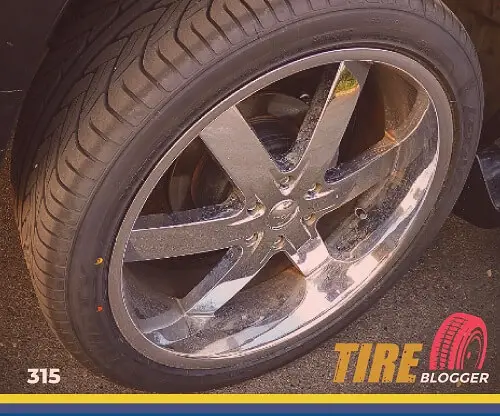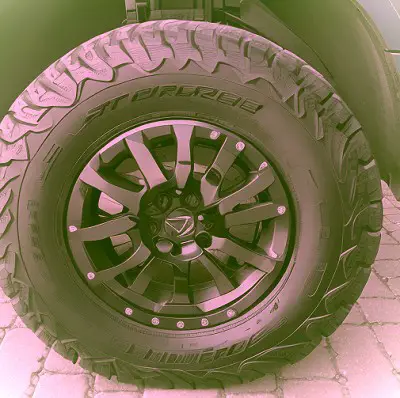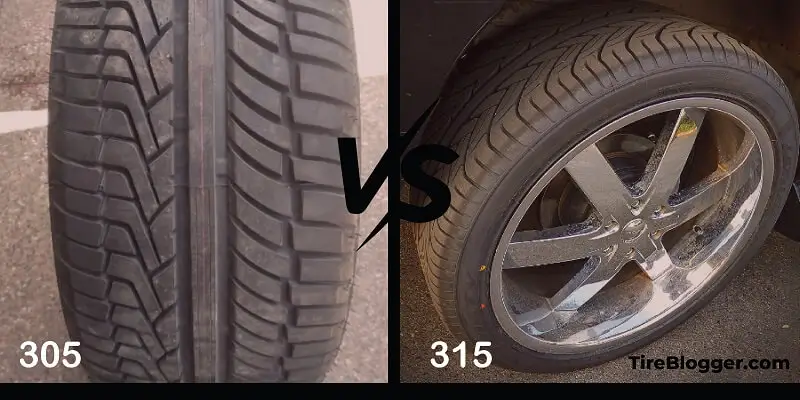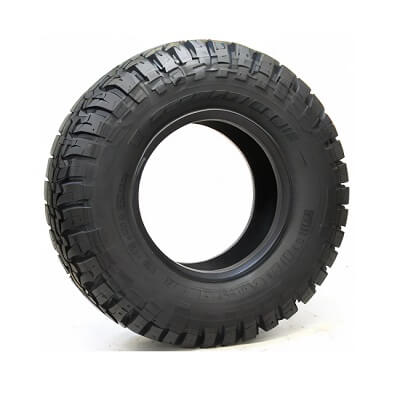305 vs 315 Tires

The main difference between a 315 and 305 tire is the width. This means a 315 tire is 10 millimeters or about 0.4 inches wider than a 305 tire. A 315 tire has a tread width of 315 millimeters, while a 305 tire has a tread width of 305 millimeters.
315 vs 305 Table
Here’s a comparison table that will assist you in quickly comprehending the distinctions.
| Tire Size 305 | Tire Size 315 |
|---|---|
| Slightly better fuel efficiency | Slightly more traction and stability |
| More responsive handling | Improved ground clearance |
| Quieter ride and less vibration | More cushioned ride |
| Longer tread life | Bold, aggressive aesthetics |
| Easier snow/ice navigation | Enhanced performance in mud and sand |
| Lighter weight | Wider tread and sidewalls |
| Smaller contact patch | Marginally larger overall diameter |
| Lower speedometer reading | Slightly higher speedometer reading |
Ground Clearance
A 315 tire provides slightly more ground clearance than a 305, thanks to the extra tread width.
This can be advantageous for off-roading or driving over rough terrain, as the increased clearance helps prevent scraping the underside of your vehicle.
However, the difference is relatively small at just 10mm, so the impact on ground clearance is minor.

Gas Mileage
The slightly smaller 305 tire has a slight edge regarding fuel efficiency. The smaller contact patch and decreased rolling resistance lead to marginally better gas mileage than the wider 315 tires.
However, the difference is minimal, and both tire sizes should deliver comparable fuel economy.
Ride Comfort
Ride comfort is impacted more by tire construction and rubber compounds than width alone. However, the extra sidewall height on a 315 provides more cushioning from impacts like potholes.
The wider 315 may also generate slightly more road noise, while the 305 transmits fewer vibrations. Overall comfort levels are similar between the two.
Aesthetics Look
The aggressive, bulging sidewalls of a wider 315 tire provide a more bold, masculine visual appeal than the 305.
However, lower-profile 305 tires can also lend a sporty look. Aesthetics ultimately come down to personal taste, but the slightly wider 315 does offer more presence.

Handling & Stability
The 305 has a minor handling and steering response advantage, thanks to the smaller contact patch and lighter overall weight.
But the wider 315 promotes stability, especially when cornering or traversing uneven road surfaces. Ultimately, the differences in handling are quite small between these two tire widths.
Noise & Vibration
The 305 transmits fewer vibrations and slightly less road noise than the marginally wider 315. However, tread design has a greater impact on noise levels.
Neither width is distinctly noisier or causes significant extra vibration, so differences are negligible.
Durability & Wear
With a slightly smaller contact patch, the 305 exhibits marginally less wear over time and may provide longer tread life.
However, high-quality tires in both sizes can deliver comparable durability when appropriately maintained. The minor width difference does not significantly impact overall tire life.

Adverse Conditions
Thanks to the wider tread, the 315 has a slight edge for traction in mud, sand, and deep snow. But a narrower 305 can sometimes cut through snow and ice more effectively.
Ultimately, tire construction has a greater impact than width alone regarding performance in adverse conditions.
Speedometer Reading
Due to the minor diameter difference between 315 and 305 tires, speedometer readings will be virtually identical.
You may see a 1-2% difference at most, usually with the wider 315 tires showing a slightly lower reading. But this is a negligible discrepancy in real-world driving.
Difference Between 305 and 315 Tires
The main difference is the section width, with 315 tires being 10mm wider than 305 tires. This affects performance factors like grip, handling, and fuel efficiency.
Can I Use 305 Tires Instead of 315?
Yes, it’s possible to use 305 tires instead of 315. The rim width ranges overlap, making it suitable. However, ensure the aspect ratio and rim diameter match your current setup. If they don’t, keep the overall diameter difference within 3% to maintain vehicle performance.

Can I Use 315 Tires Instead of 305?
Yes, you can use 315 tires instead of 305. The rim width ranges overlap, allowing for this switch. Remember to match the aspect ratio and rim diameter with your current setup. If they differ, keep the overall diameter difference within 3% to avoid performance issues.
Can I Put 305 Tires on 315 Rims?
Yes, you can put 305 tires on rims designed for 315 tires. The ideal rim width range for 305 tires (9.5-11.0 inches) overlaps with the range for 315 tires (10.0-11.5 inches), ensuring proper fitment and performance.
Can I Put 315 Tires on 305 Rims?
Yes, you can put 315 tires on rims designed for 305 tires. The ideal rim width range for 315 tires (10.0-11.5 inches) overlaps with the range for 305 tires (9.5-11.0 inches), ensuring proper fitment and performance.
Our Observation
After comparing the minor differences between 315 and 305 tire widths, I don’t see one as being clearly superior overall. The slightly wider 315 provides a bold, aggressive look that I find aesthetically appealing for trucks and SUVs.
I also appreciate the marginal gains in stability and traction from the wider tread, even though a 305 can cut through snow more effectively. For most drivers who split time between highways and light off-roading, I think the 315 offers the best blend of on-road manners and off-road capability.
While a 305 promotes handling and fuel economy to a small degree, the wider 315 better suits my preferences for both styling and real-world performance. Ultimately, either width can work very well, depending on your needs.

Meet Caitlin McCormack, a Tire Size Expert and Blogger Passionate About Everything Related to Tires. With Years of Experience in the Tire Industry, Caitlin Has Become an Expert in Tire Sizes and Their Impact on Vehicle Performance.
